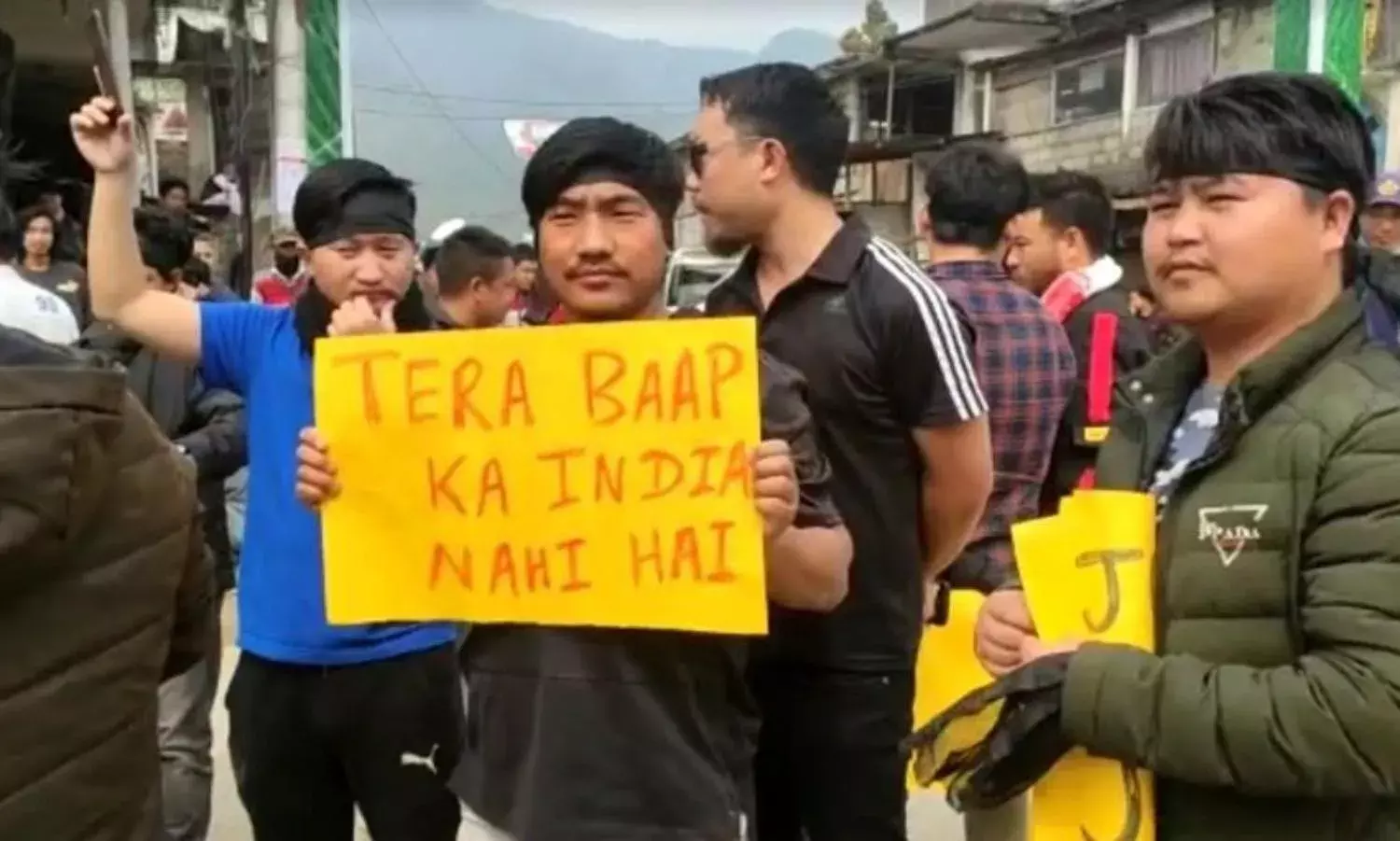Pens, Swords, and Shah Amidst CAA
Protests in Arunachal Pradesh

ITANAGAR: As Union Home Minister Amit Shah took to the lectern to speak to hundreds of invitees, officials, award winners, and representatives of political parties who had gathered at the Indira Gandhi Park here to mark the 34th Statehood Day on Thursday, he began his speech along expected lines: “Bharat Mata ki... (waits for response) arrey, jor se boliye. Modi ji ko malum chalna chahiye.”
For visiting politicians from New Delhi, it has become the norm to invoke the proverbial patriotic Arunachali and the one who greets the other fellow patriots with ‘Jai Hind’.
(In all honesty, except for men in uniform, I haven’t witnessed anyone use the term without a hint of humour.)
During his speech made on his maiden visit to the capital after the first one was cancelled due to the anti-Citizenship Amendment Act (CAA) protests that were at its peak, Shah took to the all-too-familiar patriotic rhetoric and avoided talk of the controversial law.
But at least one protest was staged today near the Nyokum Lapang ground in the capital that would have been en route the freshly paved road to the park.
Continuing with the theme of the Arunachali patriot, Shah said that this patriotism should spread across the rest of the country. It’s safe to assume that Shah was not referring to the students of the Rajiv Gandhi University who have been leading the protests against the CAA in the state capital, and others representing various indigenous people’s forums.
He and the VIP convoy missed the protestors entirely as they took an alternate route to reach the venue.
In his speech, Shah did not once mention the Act that is currently up for scrutiny in the Supreme Court as protests across the country continue to take place.
The closest he came was when he said that after the scrapping of Articles 370 and 35(A) from Jammu & Kashmir there were efforts to “spread rumours” that the BJP government will take similar action with regards to the various regulations in place across the region that seek to protect land and resource ownership of indigenous communities in the Northeast.
These measures include the inner line provision under the Bengal Eastern Frontier Regulation (BEFR), and several different sections of Article 371.
Arunachal Pradesh, however, comes under the purview of 371(H) which only provides for special powers to the governor relating to law and order in the state, and does not give local indigenous communities any special rights over the land and its resources.
Perhaps the minister chose to actively ignore and circumnavigate the topic that has already resulted in the deaths of at least 25 people directly involved in the protests. In doing so, he also (rightly) ignored the placards that were ready to greet him, one of which said: “Mota Bhai Go Back”.
So when it was clear that Shah was shielded from the protest and whisked away to the venue named after a member of the family he seems to not particularly be fond of, I headed to the venue to listen to the Union Home Minister I was met with a rude shock.
Approaching one of the entry points, I heard one of the security personnel telling someone in front of me that pens are not allowed to be taken in.
Now, as a journalist, I can’t think of anything more castrating than being separated from my pen.
In all fairness, even the security personnel said that not allowing pens to be taken inside in a place like Itanagar, where arguably the perceived security threats are relatively low, did not make sense.
Ultimately, after making a phone call to a policeman friend, I had myself ushered in with the pen firmly in the pocket of my coat that I could barely afford (journalists in the fringes don’t get paid as well), I was front and centre waiting for ‘Mota Bhai’ (not my words) to speak.
When the cultural events began, I had the opportunity to witness once again the magnificent Tapu war dance of the Adis where men donned in their regal galleria (complete with headgear and swords) inspire each other to go to battle.
As has been the case, war dances are an irreplaceable part of our tribal culture. And personally speaking, the Tapu is an enthralling ‘event’ to witness.
The irony of not allowing the pens of journalists into the venue while the swords of the Tapu dance warriors was maybe lost on those in charge of security.
In all honesty, even the security guy was befuddled as to why he had been ordered to not allow pens to be carried inside.
“Pen se kya na karega,” he said in the unique Arunachali dialect of Hindi.
My darting skills are not great. If it was, I would have hit the point of this piece sooner.
As we sat to listen to our country’s home minister, and eventually went on to wait for a good three hours to have our friends being felicitated for the state awards, Shah said something very profound.
“Before 2014, the Northeast was geographically and governance-wise joined to Bharat but after Narendra Modi, the north-east region has been joined by the heart,” he said.
Unfortunately, the distance between the region and the political leadership shows itself each time an Amit Shah or anyone from Delhi shows up to our hills.
Even after being elected to the lower house for the second time in a row and being part of Modi’s Cabinet, Shah and others still cannot pronounce our Arunachal West Lok Sabha MP’s last name with clarity.
“Kiren” is fine because it sounds so much similar to “Kiran”. But when it comes to his last name- Rijiju -for all the ‘national’ leaders, he is still Rijju.
That lack of effort is perhaps reflective of the distance between Delhi and the region, both physical and metaphorical.
P.S: It is pronounced ‘Ri-ji-ju’; not ‘Rijj-ju’



